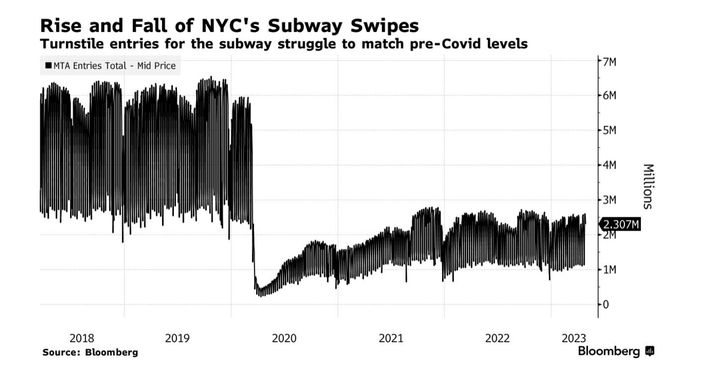America's Largest Mass-Transit Systems Are Speeding Toward a Cliff
Hat tip, a link from an online group
America’s Trains and Buses Are Speeding Toward a Cliff
By Eric Levitz, features writer for Intelligencer who covers politics and economics
America’s largest mass-transit systems are hurtling toward a doom spiral. ... The pandemic chased riders from subways and buses; then the rise of remote work kept them away. Nationwide, ridership sits at about 70 percent of pre-pandemic levels. And that figure understates the financial peril facing the country’s premier systems. Smaller transit systems in car-centric cities primarily serve working-class constituents, who are less likely to work remotely. Such systems have therefore seen ridership bounce back relatively quickly.
Large systems like D.C.’s WMATA and San Francisco’s BART, by contrast, serve a broad, socioeconomically diverse constituency. In normal times, this enables them to provide comprehensive and (by U.S. standards) high-quality service. But it also means they rely on the patronage of white-collar workers for a high percentage of their revenue through fares. And that is not an optimal way to make money in the era of remote work: WMATA rail ridership is currently stuck at 50 percent of pre-pandemic levels, while BART’s sits at an abysmal 40 percent, a figure that reflects the system’s unique reliance on tech workers, who are especially likely to work from home.
Virtually every major transit system in the United States is similarly embattled. New York’s MTA does not expect to reach 80 percent of its pre-pandemic ridership until 2025. Boston’s MBTA hopes to get to 67 percent by July. Philadelphia’s SEPTA is stuck at 60 percent and Chicago’s CTA at a similar level.

To this point, COVID-era federal funds have masked the financial implications of collapsing ridership. Across its relief packages, Congress injected $69 billion into U.S. mass-transit systems. But now that money is running out. In 2024, D.C.’s WMATA is staring down a $738 million shortfall, Boston’s MBTA will see a $475 million one, and New York’s MTA will see a deficit of more than $1 billion (that figure would have been higher were it not for the recent passage of state aid). BART’s deficit will hit $340 million by 2027, and systems in Chicago and Philadelphia are anticipating similar numbers.
{snip}
The rise of remote work can ultimately benefit workers, cities, and the climate alike. Fewer commuters make for less traffic on the streets and less carbon in the atmosphere. But in the immediate term, the work-from-home revolution threatens to unravel public services that are indispensable to urban life and ecological sustainability. Policymakers must help mass-transit systems circumvent their looming financial woes or the green transition won’t get us where we need to go on time.
progree
(10,920 posts)that were cut in October and December due to lack of drivers. Including my route in full that I've written about here a time or two or more. And many routes' frequencies have been improved (e.g. every hour to every half hour) ![]()
![]()
![]()
![]()
I just learned about that Monday. I thought my route was never coming back -- they removed the bus stop signs completely, even the poles. On most other routes that they suspended, they just stick a big yellow sticker "this stop is not currently being served by any route" or somesuch words onto the signs.
They've been slowly upping the driver pay and making it easier to qualify, and have finally started reducing the driver shortage.
As for money restrictions, I haven't heard of any, it's all been about number of drivers. But I'm worried that's coming down the road. Fortunately, we have a trifecta in Minnesota (a D governor and both houses of the legislature are D) but inevitably that rare circumstance won't always be the case.
As for ridership -- how to summarize.. https://www.metrotransit.org/performance
Its also somewhat seasonal so one should compare a given month to the same month in previous years. Comparing March 2023 to March 2019 (way pre-pandemic) we're about 50% of the March 2019 total ridership.
In that time interval a couple of BRT routes (Bus Rapid Transit) have entered service, boosting ridership. But as mentioned above, many routes were cut or dialed back in frequency. So we're not seeing a clear picture of demand from this.